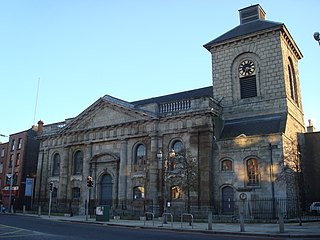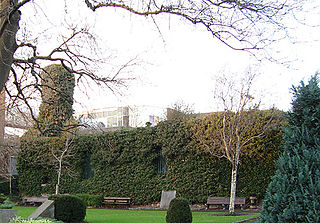Related Research Articles

The Northside in an informal but commonly used term to describe the part of the city of Dublin that lies to the north of the River Liffey, and extending into part of North County Dublin. The part outside the city is within the county of Fingal, a local government area established in 1994. While it is sometimes regarded as less wealthy than the city's Southside, the Northside was originally the home of the city's upper classes and the more privileged of the two. Today, some of the wealthiest areas in Ireland, such as Malahide, Howth, Clontarf, and Castleknock, lie north of the river.

St. Michan's Church is a Church of Ireland church located in Church Street, Dublin, Ireland. The first Christian chapel on this site dated from 1095, and operated as a Catholic church until the Reformation. The current church dates from 1686, and has served Church of Ireland parishioners in Dublin for more than 300 years.

Oxmantown was a suburb on the opposite bank of the Liffey from Dublin, in what is now the city's Northside. It was founded in the 12th century by Hiberno-Norse Dubliners or "Ostmen" who either migrated voluntarily or were expelled from inside of the city walls of Dublin after the Anglo-Norman invasion and the 1171 beheading of Hasculf, the last Hiberno-Norse King of Dublin by the invading army. The settlement was originally known as Ostmanby or Ostmantown.

Smithfield is an area on the Northside of Dublin. Its focal point is a public square, formerly an open market and common, now officially called Smithfield Plaza, but known locally as Smithfield Square or Smithfield Market. Historically, Smithfield formed the western part of Oxmantown and lay close to Oxmantown Green.

St Mary's Church, Dublin is a former Church of Ireland building on the corner of Mary Street and Jervis Street, Dublin, adjacent to Wolfe Tone Square. From the 17th century, the church was a place of worship for parishioners on Dublin's northside, before it was closed in 1986. The church has since been deconsecrated and the building is now a pub and restaurant. The parish also had a chapel of ease - St Mary's - off Dorset Street, more commonly known as "The Black Church".

St Doulagh's Church is the oldest stone-roofed church still in use in Ireland. It is situated approximately 10 kilometres from Dublin city, just north of the hamlet of Balgriffin, within Fingal and in the traditional County Dublin, and is marked as "St Doulagh's Church, Balgriffin". Its complex also comprises an octagonal baptistry built over a holy well - Ireland's only surviving standalone baptistry - and a stone housing over a pool. St Doulagh's is one of the two churches in the Church of Ireland "United Parishes of Malahide, Portmarnock and St Doulagh's.

The Parish of Taney is a populous parish in the Church of Ireland, located in the Dundrum area of Dublin.

St Audoen's Church is the church of the parish of Saint Audoen in the Church of Ireland, located south of the River Liffey at Cornmarket in Dublin, Ireland. This was close to the centre of the medieval city. The parish is in the Diocese of Dublin and Glendalough. St Audoen's is the oldest parish church in Dublin and is still used as such. There is a Roman Catholic church of the same name adjacent to it. In 2012 the parish was merged with St. Catherine and James Church on Donore Ave.

St. Catherine's Church, on Thomas Street, in Dublin, Ireland, was originally built in 1185. It is located on what was once termed the "Slí Mhór", a key route that ran westwards across Ireland from Dublin. The church was rebuilt in its present form in the 18th century by John Smyth.

There was a St. Kevin's Church in what is now St. Kevin's Park, Camden Row, Dublin, Ireland at least as far as the 13th century. After the Reformation, it became an Anglican church. The original church was replaced around 1750 by a new one, closed in 1912 and now in ruins. Both churches were dedicated to Kevin of Glendalough. There is also a Catholic St. Kevin's Church a short distance away on Harrington Street.
John Parker was a Church of Ireland clergyman who came to prominence after the English Restoration, first as Bishop of Elphin, then as Archbishop of Tuam and finally as Archbishop of Dublin and Primate of Ireland.

St. George's Church is a former parish church in Dublin, Ireland. Designed by Francis Johnston, it is considered to be one of his finest works. The structure is located at Hardwicke Place, just north of the city centre, though when it was opened this was considered to be in Drumcondra. The elegant spire, 200 feet (61.0 m) high, became a landmark of the north inner city. Along with St Andrew's Church, Chennai, it is considered one of the finest stylistic "daughter" churches to London's St Martin-in-the-Fields.

St. Peter's Church was a former Church of Ireland parish church located in Aungier Street in Dublin, Ireland, where the Dublin YMCA building now stands. It was built on land that formerly belonged to the Whitefriars in Dublin. It served the largest Church of Ireland parish in Dublin.

Merrion Cemetery, Bellevue is a cemetery located on Bellevue Avenue off the Merrion Road in Dublin, Ireland a short distance to the north west of Booterstown. The recently demolished "Tara Towers" hotel was adjacent to the graveyard. The cemetery was in use from 1300 to 1866. Since 1978 it has been used as a public park under the care of Dublin City Council

Grangegorman is an inner suburb on the northside of Dublin city, Ireland. The area is administered by Dublin City Council. It was best known for decades as the location of St Brendan's Hospital, which was the main psychiatric hospital serving the greater Dublin region. As of 2020, the area is the subject of a major redevelopment plan, running for more than a decade, under the aegis of the Grangegorman Development Agency, including the new Technological University Dublin campus.
Clonmethan is a townland and a civil parish in the ancient barony of Balrothery West, Fingal in Ireland. It is bordered by the parishes of Palmerstown to the west, Grallagh to the north, Hollywood to the northeast, Westpalstown to the east, Killossery to the southeast, Killsallaghan to the south, and Greenoge, County Meath to the southwest.

All Saints Church, Grangegorman is a Church of Ireland church located in Dublin, Ireland. It was built in 1828, to designs by John Semple, and formed as a parish in 1829 from the areas of St. Michan's and St. Paul's. It is a constituent member of the Christ Church Cathedral, Dublin Parish Group alongside St. Michan's Church, Dublin and St. Werburgh's Church, Dublin. This church in noteworthy on the basis that it is numbered among the first in Ireland to worship according to Tractarian Principles, and was the subject of protest and sanction by the Protestant community in Ireland in the 19th century.

John Pooley (1645-1712) was a member of the Church of Ireland, who was Bishop of Cloyne from 1697 to 1702, then Bishop of Raphoe until his death in October 1712.

St. Michan's Catholic Church is a Catholic Church located on the Northside of Dublin, Ireland. It is the parish church for the Halston Street Parish in the Archdiocese of Dublin.
Cloghran Parish Church was a Church of Ireland church for an ancient parish in the Barony of Coolock in northern County Dublin, 1.5 miles (2.4 km) south of Swords, Dublin. It was also known as Cloghran-Swords to distinguish it from another parish of the same name Cloghran, Castleknock in western Dublin. Cloghran was united to Santry in 1872 by decision of the Dublin Diocesan Synod The graveyard is all that remains following the demolition of the church structure. The graveyard includes burials of Catholics as well as Protestants.
References
- ↑ About us SPADE Enterprise Centre.
- ↑ SPADE Enterprise Centre, King Street North, Dublin 7, DUBLIN Buildings of Ireland.
- ↑ Smithfield and Stoneybatter History.
- ↑ Dublin City Parishes 1830s Ireland, History and Genealogy.
- ↑ ST PAUL'S CHURCH. NORTH KING ST DUBLIN. PLAN SHOWING EXISTING ARRANGEMENTS. PROPOSED ALTERATIONS GROUND PLAN. GALLERY PLAN. ALBERT E MURRAY ARCH – RCB( www.ireland.anglican.org)
- ↑ St Paul's Parish, Dublin by Edith M. Best, The Journal of the Royal Society of Antiquaries of Ireland, Vol. 104 (1974), pp. 15–28 (14 pages).
- 1 2 3 Remains found in Dublin adds intrigue to search for Robert Emmet’s grave by Ronan McGreevy, The Irish Times, September 20, 2021.